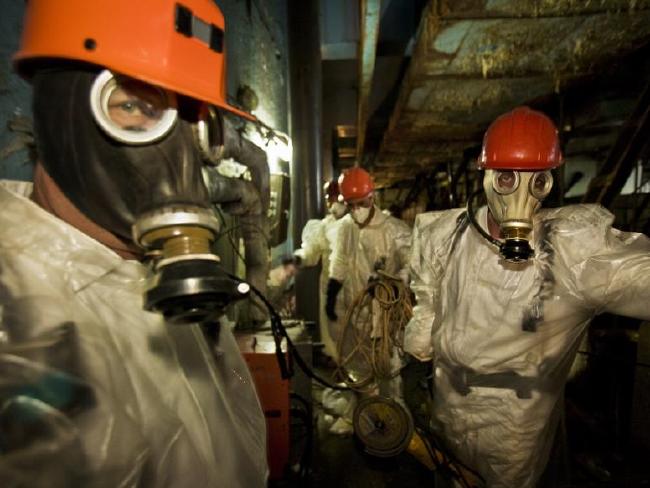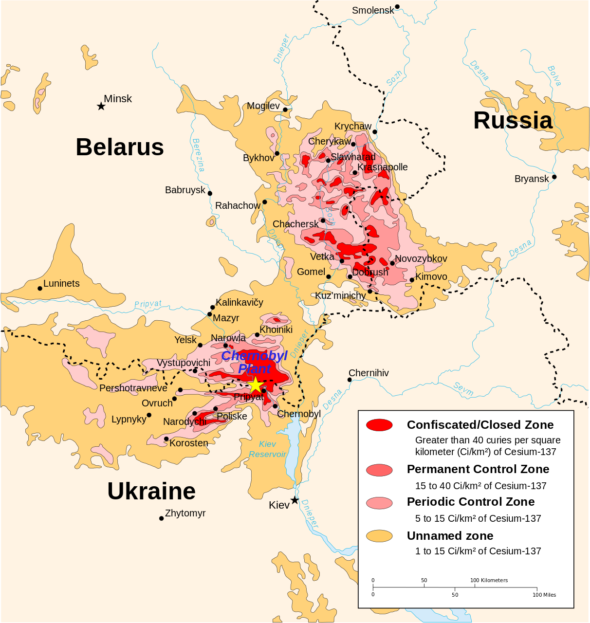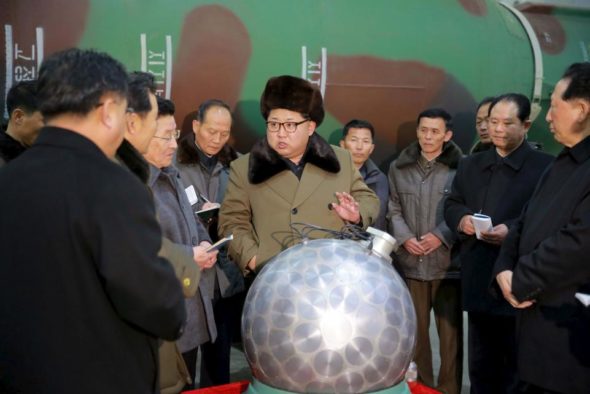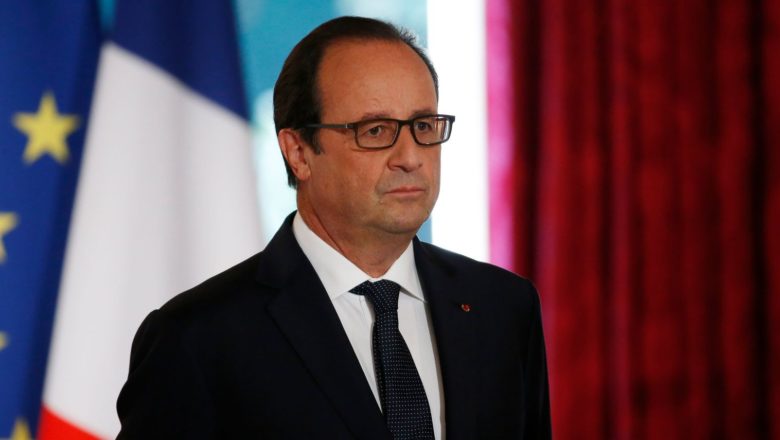
Workers wearing plastic suits and respirators for protection pause briefly on their way to drill holes for support rods inside the shaky concrete sarcophagus, a structure hastily built after the explosion to isolate the radioactive rubble of Reactor 4.
redo Jump to...
print Print...
UKRAINE – Massive shelter is placed atop Chernobyl nuclear reactor
(from AP at CBS) – Workers completed a massive shelter over the Chernobyl nuclear plant’s exploded reactor last Tuesday (Nov.30), one of the most ambitious engineering projects in the world.
The half cylinder-shaped shelter [named The New Safe Containment] was locked in place over the plant’s reactor No. 4 after being moved in on hydraulic jacks for two weeks. It marks a significant step toward containing the consequences of the world’s worst nuclear accident, which occurred 30 years ago in what [was then part of the Soviet Union and] is now Ukraine.
Ukrainian President Petro Poroshenko described the new shelter as “the biggest moving construction that humanity has ever created.”
Workers will now begin dismantling unstable parts of the original cover, the so-called sarcophagus, which was built over the reactor shortly after the 1986 disaster to contain radiation.
The new shelter is 843 feet wide and 354 feet tall, took several years to build and cost about 1.5 billion euros, according to the European Bank for Reconstruction and Development [EBRD]. More than 40 governments have contributed to funding its construction, which involved 10,000 workers.
Vince Novak, the ERBD’s nuclear safety director said, “The New Safe Confinement is an unprecedented engineering success. It is an extremely complex structure built in a contaminated area.”
“It’s one of the most important projects ever done. People in Ukraine and not only Ukraine — across Europe and large parts of the world — still remember the 1986 accident,” Mr. Novak told Reuters.
The hi-tech covering of the disaster zone has been “eagerly awaited” and is “huge news and not only for people of Ukraine, for people of Europe, people of the world. It’s a huge technological achievement.”
To minimize risk to those involved the structure was mostly built away from the site and slid onto the area [last] week. Even with the concrete sarcophagus that has encased the failed reactor, there was still the chance radiation could leak out or the concrete building would collapse.
The huge steel arch was moved into place over several weeks, and the completion of this procedure was celebrated with a ceremony at the site on Tuesday (Nov. 29), attended by the Ukrainian president, Petro Poroshenko, diplomats and site workers.
Over the coming year, work will continue on the structure to make it airtight and dismantle parts of the sarcophagus inside, using remote-controlled cranes inside the structure. When it is completed in November 2017, the final structure should ensure that the site is airtight for 100 years.
Reactor Number 4 of the Chernobyl nuclear power plant exploded during an experimental safety check in the middle of the night on April 26, 1986. It spewed radioactive contents up to one kilometre into the sky, some falling as debris in the area while the rest was blown by the wind as far as western Europe.
Thirty rescue workers and plant staff, receiving abnormally high doses of radiation, were killed at the site either immediately or in the coming weeks. The noxious plumes drifted to the northwest, polluting the Soviet republics of Ukraine, Belarus and Russia. The harmful clouds then reached Scandinavian countries before swinging southward and westwards, dropping contaminated rain on central Europe and the Balkans, Italy, France, Britain and Ireland.
Soviet authorities remained silent on the disaster for three days without informing people in nearby villages about the need to evacuate. The official news agency TASS only reported on the accident on April 28 after the Forsmark nuclear plant in Sweden detected unusually high radiation in the environment.
One hundred thousand people were eventually evacuated from an area within 30 kilometres of the plant only weeks later.
In November 1986 a 50-metre-high concrete shelter, dubbed a sarcophagus, was completed to prevent further leakage of radiation from tonnes of highly radioactive magma and allow the other three reactors at Chernobyl to continue producing power for Ukraine.
The concrete sarcophagus was only meant to be temporary and expected to last a couple of decades. But in 1993 its lifespan was estimated at only seven years.
In December 2000 after years of international pressure, the Ukraine government finally agreed to switch off the last reactor at the site and close down the Chernobyl facility.

NORTH KOREA – Government hit with stronger sanctions by U.N. Security Council
(by Pamela Falk, CBS News) – The U.N. Security Council on Wednesday unanimously passed a tough, loophole-closing resolution, written by the U.S. and China, that severely tightens sanctions on North Korea and takes aim at its coal exports – the principal source of revenue for the cash-starved regime of Kim Jong Un.
A U.S. diplomat familiar with the negotiations said that the new resolution strengthens sanctions against North Korea in order to lower the revenues that the country, known officially as the Democratic People’s Republic of Korea (DPRK), “uses to raise hard currency to fund its nuclear and ballistic missile programs and slashes the DPRK’s exports by more than $800 million per year.”
The 17-page resolution refers to the “gravest concern” caused by the nuclear test conducted by North Korea on Sept. 9, a test that was the country’s most powerful detonation to date.

North Korean leader Kim Jong Un meets nuclear scientists and technicians in this undated photo released by North Korea’s Korean Central News Agency in Pyongyang on March 9, 2016.
The reaction by world powers to the September test was swift: South Korea called an emergency meeting of its security officials; U.N. Secretary-General Ban Ki-moon condemned the test as a “brazen breach” of U.N. resolutions; President Obama said the U.S. “does not and never will” accept North Korea as a nuclear state; U.S. Ambassador Samantha Power said that the U.N. must “demonstrate to North Korea that there are consequences for its unlawful and dangerous actions.”
At the time, the U.N. called an emergency meeting of the Security Council and has been negotiating for a new redoubling of sanctions that would be targeted at the leadership of North Korea that are not intended to have adverse humanitarian consequences on the civilian population.
Thomas Byrne, president of the nonprofit Korea Society and former head of Moody’s Asia division, told CBS News that the September nuclear test pushed China to act.
“They see North Korea as hell-bent on developing its nuclear weapons and ballistic missiles programs and that is ultimately very destabilizing,” he said. …
The goal of Wednesday’s resolution was to convince Pyongyang to return to the negotiating table in order to agree to verifiable denuclearization. Byrne added that it was important to tamp down North Korean resources without having a negative effect on China’s economy.
And that is precisely what this resolution achieves. According to the Chinese National Bureau of Statistics, China produced 3.7 billion metric tons of coal in 2015 and is on track to produce the same or more in 2016, so the loss of North Korean imports will be less than one-half of 1 percent of what China produces. …
What type of negotiations the North Koreans would return to, however, is unclear. Six-party talks between China, the U.S., North and South Korea, Japan and Russia began in 2003 but stalled by 2009 and have not restarted; in 2011, the U.S. and North Korea had bilateral talks to restart the multi-party negotiations, but those also failed.
Ban, the outgoing secretary-general, who is South Korean, tried to bring the talks back and was invited to North Korea in 2015 but was rebuffed at the last minute by Pyongyang. …
FRANCE – France’s Hollande throws in the towel
French President François Hollande said on Thursday he would not seek re-election next year, bowing to historically low approval ratings after a troubled term in power.
The withdrawal means the 62-year-old Socialist leader is the first president of France’s fifth republic, founded in 1958, to step aside after only one term.
“I have decided that I will not be a candidate,” a stony-faced Hollande said in a solemn televised statement from the Élysée Palace in Paris during which he defended his record.

French President François Hollande
He conceded that he was unable to unite his deeply divided Socialist Party behind his candidacy ahead of the presidential election in April and May next year.
“In the months to come, my only duty will be to continue to lead my country,” he said.
Hollande’s approval ratings have hit rock bottom after a term in office marked by U-turns on major policies, terror attacks, high unemployment and embarrassing revelations about his private life.
He is the most unpopular president in French polling history, a fact he tacitly acknowledged in his speech on Thursday.
“I am aware today of the risk that going down a route that would not gather sufficient support would entail, so I have decided not to be a candidate in the presidential election,” he said.
A new poll on Wednesday predicted he would win just seven percent of votes in the first round of next year’s election in April – strengthening Socialist critics who view him as a lame duck.
A divided left
Voter surveys currently tip rightwing Les Républicains party candidate François Fillon to become the next president, with the far-right National Front candidate Marine Le Pen seen as his closest challenger.
But with the full range of candidates still unknown and the role of independents such as 38-year-old former economy minister Emmanuel Macron difficult to predict, analysts urge caution about the forecasts. …
Mr Normal’s rollercoaster ride
Hollande took office in 2012 promising to be “Mr Normal” after what were seen as the excesses of the years under president Nicolas Sarkozy, who married supermodel Carla Bruni and was often pictured with millionaire friends.
But his presidency has been anything but normal.
France has faced three major terrorist attacks since January 2015 – first against the Charlie Hebdo magazine, then in Paris in November and in Nice in July.
On economics, Hollande started with a leftist program that included a wealth super-tax of 75 percent on top-earners but he shifted course mid-way through his term to embrace pro-business reforms, soon alienating grassroots supporters on the left.
And his colorful personal life has never been far from the headlines, leading his opponents to claim he has demeaned one of the most powerful political offices in Europe.
In January 2014, celebrity magazine Closer published pictures of him arriving on a scooter at an apartment near his official residence for secret trysts with a French actress, Julie Gayet.
The revelations led to the break-up of Hollande’s relationship with partner Valérie Trierweiler, who went on to write an eviscerating book that claimed the president mocked poor people as “the toothless”.
A mixed legacy
Hollande listed his achievements on Thursday night, saying he had worked to “get France back on track and make it more fair” through reforms to the economy, social security and education.
He pointed to a global accord on climate change signed in Paris last year as part of his legacy, as well as his handling of the terror attacks when he had sought to heal and comfort a wounded country.
On unemployment — which Hollande had promised to lower before the election – he said “the results are coming, later than I had promised them, but they are there.”
His decision not to seek re-election came on a day when Le Monde, France’s newspaper of record, delivered a withering assessment of his time in office.
Le Monde wrote in an editorial that the Socialists risked tearing themselves apart ahead of the presidential election as well as a parliamentary vote in June.
“The person who is most responsible is François Hollande, who has not given a meaning to his time in office, occupied the job with authority or imposed himself as the legitimate candidate for his party,” it said.
(The news briefs above are from wire reports and staff reports posted at CBSNews on Nov. 29 [Ukraine], November 30 [NKorea] and France24 on Dec. 2 [France].)
Questions
1. For each of the 3 countries, give the following information:
- capital
- location/the countries that share its borders
- the religious breakdown of the population
- the type of government
- the chief of state (and head of government if different) If monarch or dictator, since what date has he/she ruled? – include name of heir apparent for monarch
- the population
Find the answers at the CIA World FactBook website. For each country, answers can be found under the “Geography” “People” and “Government” headings.
NOTE to students: Before answering the questions below, read the information under “Background” and watch the new videos under “Resources.”
2. For UKRAINE:
a) list the who, what, where and when of the news item
b) When did the Chernobyl nuclear disaster occur?
c) What is significant about the new shelter erected over Reactor No. 4?
d) How much did the new shelter cost? How many workers were involved? How long did it take to build?
e) Why was the new shelter built off-site and then moved into place when completed?
3. For NORTH KOREA:
a) list the who, what, where and when of the news item
b) Define revenue.
c) What is North Korea’s main source of revenue?
d) Watch the video under “Resources” Why might the new sanctions against North Korea not mean anything, according to analyst Gordon Chang?
4. For FRANCE:
a) list the who, what, where and when of the news item
b) What is the significance of President Hollande’s decision?
c) Why did he say he made this decision?
d) List the reasons for President Hollands’ unpopularity.
e) Who is expected to win the next presidential election in France?
f) France is an example of a democratic socialist state. In 2012, French voters elected the Socialist Party candidate, François Hollande, into office with the expectation that he would meet his campaign promises to introduce greater socialist policy.
Why do you think French voters, after having elected Hollande, might quite possibly elect the right-leaning Fillon as the next president?
Background
UKRAINE
THE CHERNOBYL DISASTER:
- The Chernobyl disaster was a nuclear accident of catastrophic proportions that occurred on April 26, 1986, at the Chernobyl Nuclear Power Plant in Ukraine (then in the Ukrainian Soviet Socialist Republic, part of the Communist Soviet Union [USSR]). — In 1922, Ukraine became one of the original constituent republics of the Union of Soviet Socialist Republics (USSR.); it would not regain its independence until the USSR’s collapse in 1991.
- It is considered the worst nuclear power plant accident in history and is the only level 7 event on the International Nuclear Event Scale.
- The disaster occurred on April 26 1986, 1:23 A.M., at reactor number 4 at the Chernobyl plant, near the town of Pripyat, during a safety test.
- A sudden power output surge took place, and when an attempt was made at an emergency shutdown, a more extreme spike in power output occurred which led to the rupture of a reactor vessel as well as a series of explosions.
- This event exposed the graphite moderator components of the reactor to air and they ignited; the resulting fire sent a plume of radioactive fallout into the atmosphere and over an extensive area, including Pripyat.
- The plume drifted over large parts of the western Soviet Union, and much of Europe. As of December 2000, 350,400 people had been evacuated and resettled from the most severely contaminated areas of Belarus, Russia, and Ukraine.
- According to official post-Soviet data, up to 70% of the fallout landed in Belarus.
- Following the accident, Ukraine continued to operate the remaining reactors at Chernobyl for many years. The last reactor at the site was closed down in 2000.
- The accident raised concerns about the safety of the Soviet nuclear power industry as well as nuclear power in general, slowing its expansion for a number of years while forcing the Soviet government to become less secretive about its procedures. (from wikipedia)
and from an Agence France-Presse report at Japan Times:
- For 10 terrifying days, the nuclear fuel kept burning, spewing clouds of poisonous radiation that contaminated up to three-quarters of Europe, with Ukraine and neighboring Belarus and Russia hit especially hard.
- As the horror unfolded, the Soviet authorities said nothing publicly, in keeping with a tradition of preventing people from learning of tragedies that could tarnish the image of the Cold War-era superpower.
- They evacuated the 48,000 inhabitants of the town of Pripyat, located just 3 kilometers (1.8 miles) from the plant, only the following afternoon.
- The first alarm was raised on April 28 by Sweden, which detected an unexplained rise in its own radiation levels.
- In his second year on the job, the leader of Russia, Communist Party Secretary-General Mikhail Gorbachev, did not publicly admit the disaster until May 14.
- With the scale of what had happened now out in the open, the authorities in 1986 relocated 116,000 people from the 30-km Exclusion Zone that surrounds the now-idled plant.
- Subsequent years saw 230,000 others experience the same fate [relocation]. Yet 5 million Ukrainians, Belarusians and Russians still live in areas where radiation levels are high.
For a 2006 report “Chernobyl 20 years later” from the BBC that includes photos, go to news.bbc.co.uk/2/hi/in_depth/europe/2006/chernobyl/default.stm.
NORTH KOREA
The resolution has several provisions that Security Council members hope will bring North Korea to talks:
- Imposes a binding cap, cutting coal exports by 62 percent
- Bans the export of metals such as copper, nickel, silver and zinc
- Imposes restrictions on access to the international financial system
- Designates 11 government officials and 10 entities for targeted sanctions
- Restricts diplomats from smuggling illicit items
- Prohibits the sale of new vessels and helicopters to North Korea
- Clarifies cargo inspection obligations
U.N. diplomats are hoping that the new resolution will bring Pyongyang to the bargaining table. U.K. Ambassador Matthew Rycroft said last week that the Security Council has been negotiating since the September test.
“It’s high time for the Security Council to come together to tighten up the sanctions regime against DPRK to impose additional measures,” Rycroft said.
Rycroft told CBS News that the new resolution imposes the strongest sanctions that the Security Council has ever imposed.
Last month, U.S. Deputy Secretary of State Antony Blinken said, “China and Russia – North Korea’s traditional guarantors – are tiring of defending the increasingly erratic and outlying regime.” (from the article above)
FRANCE – Francois Fillon, expected to be elected next president of France:
- Since his victory in the November 20th primaries, Fillon was seen as the frontrunner in the presidential elections.
- As a presidential candidate, Fillon aims to reduce the public sector and cut 500,000 civil-service jobs. Fillon has been compared to Margaret Thatcher due to his ambition to reduce the size of the state.
- Fillon is in favor of increasing the retirement age to 65.
- Fillon is an advocate of cracking down on Salafism and Muslim Brotherhood-linked groups and has stridently warned against the threat of “Islamic totalitarianism.”
- Fillon is a devout Catholic. As member of the National Assembly Fillon voted against the equalization of the age of consent for homosexual relations in 1982, against civil solidarity pacts in 1999, and against the legalization of same-sex marriage in 2013. He opposes adoption by same-sex couples.
- Fillon has stated that he is personally opposed to abortion but would not vote to ban it. (from wikipedia)
Daily “Answers” emails are provided for Daily News Articles, Tuesday’s World Events and Friday’s News Quiz.



